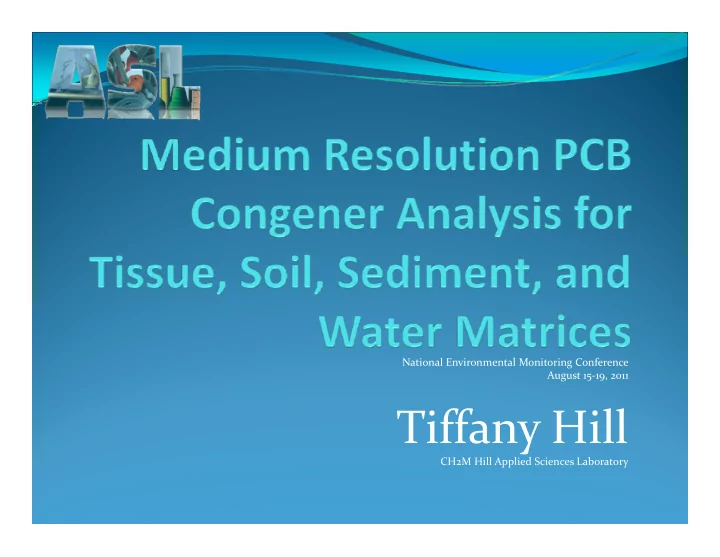

National Environmental Monitoring Conference August 15 ‐ 19, 2011 Tiffany Hill y CH2M Hill Applied Sciences Laboratory
Overview PCBs and PCB Analysis Aroclor™ vs. Congener Analysis Medium Resolution GC/MS Analysis Case Studies Applicability and Accreditation
Polychlorinated Biphenyls (PCBs) PCBs are biphenyl molecules with between 1 and 10 Chlorines attached to the two rings. 3 2 2 ’ ’ 3 ’ ’ 4 4 4 ’ 4 Cl n Cl n 5 6 6 ’ 5 ’ This allows for 209 PCB congeners that have between 1 and 10 Chlorines and 10 Chlorines.
PCB Analysis PCBs were marketed and sold as Aroclors™. Aroclors™ are: 1221, 1232, 1242, 1248, 1254, 1260, 1262, 1268, and 1016. 68 d 6 Each Aroclor™ was a mixture of different congeners that contained an amount of Chlorine as a percent that contained an amount of Chlorine as a percent. Historically, PCBs have been analyzed as these Aroclor™ mixtures by GC/ECD. y This is difficult for mixtures of Aroclors™, weathered samples, samples with significant matrix/background.
PCB Analysis (cont.) Subsequently, PCB analysis as congeners was developed using GC/ECD. Poor separation, small number of congeners as analytes. P i ll b f l EPA 1668A was developed and uses a HRGC/MS to analyze for all of the 209 PCB congeners analyze for all of the 209 PCB congeners. Still has some co ‐ eluting congeners. CH2M HILL’s Applied Sciences Lab developed a CH2M HILLs Applied Sciences Lab developed a GC/MS method using large volume injection and selected ion monitoring to analyze for a subset of approximately 100 PCB Congeners. i l PCB C
PCB Analysis Comparison Aroclors™ E1668A CH2M Hill’s Medium Resolution GC/MS Fast Analysis Long Analysis Long Analysis Only identifiers Only identifiers Identifies all congeners, Identifies all congeners Identifies subset of Identifies subset of Aroclors™ homologues congeners, homologues $ $$$$$ $$ Easy to compare to Large amounts of new Moderate amounts of hi historical data i l d d data new data d
Medium Resolution GC/MS Medium Resolution GC/MS Analysis Using a standard GC/MS with a large volume injection system operating in selected ion monitoring mode ASL is capable of achieving reporting limits similar to ASL is capable of achieving reporting limits similar to EPA 1668A. Standard sample preparation techniques are used. Standard sample preparation techniques are used. Extracts are cleaned up as needed. 50 ‐ 100 L of sample is injected into a programmable inlet. Congeners are separated over 2 hours of analysis time. Congener co ‐ elutions still occur. C l ti till
Medium Resolution GC/MS Medium Resolution GC/MS Analysis (cont.) CH2M HILL’s ASL has developed a standard list of approximately 100 congeners. These congeners comprise all congeners present at greater than 1% in a known Aroclor™ mixture in a known Aroclor mixture. Congeners include all of the WHO/NIST/NOAA coplanar congeners. This ensure that 90% or more of all Aroclors™ that were produced p are identified by this method. d f d b h h d Additional congeners are added at the request of clients. The method utilizes isotopic dilution for calibration and analysis analysis. Labeled surrogate standards are used as internal standards for quantitation. Automatically corrects for extraction/preparation efficiency. y /p p y
Medium Resolution GC/MS Medium Resolution GC/MS Analysis (cont.) A full and standard quality control/quality assurance system is utilized and monitored for this analysis. Includes blanks, ongoing precision and recovery I l d bl k i i i d standards, clean up/travel surrogates, calibration, second source verification, LOD/LOQ determination. Q This method provides the ability to analyze individual congeners or homologues. Matrices analyzed include: Water, Soil, Sediment, Tissue, Air (using PUF cartridges labeled with travel surrogates) surrogates).
Reporting Limits Matrix Reporting Limit W Water (1L) ( L) 0.50 ng/L /L 0.10 g/kg 0 10 g/kg Soil/Sediment Soil/Sediment (10 g) 0.20 g/kg Tissue (5 g) ( ) Air Air 0 5 ng/sampling 0.5 ng/sampling device
Case Studies ‐ Interlaboratory Study Case Studies Interlaboratory Study Sample 1 Homologue l ASL Method h d E1668 RPD Total monoCB 0 U 0.68 NC Total diCB Total diCB 16 8 16.8 16 8 16.8 0 2 0.2 Total triCB 61.3 60.8 0.8 Total tetraCB 23.3 26.4 12.6 Total pentaCB 2.02 2.59 24.8 Total hexaCB 0.52 0.65 22.1 Total heptaCB Total heptaCB 0.07 0.07 0.13 0.13 60.4 60.4 Total octaCB 0.00 0.00 NC Total nonaCB 0.00 0.00 NC T t l d Total decaCB CB 0.00 0.00 NC NC Total PCB 105 108 3.0
Case Studies ‐ Interlaboratory Study Case Studies Interlaboratory Study Sample 2 H Homologue l ASL M ASL Method h d E 668 E1668 RPD RPD Total monoCB 0.00 0.62 NC Total diCB 19.0 9 17.5 7 5 8.1 Total triCB 61.2 58.9 3.8 Total tetraCB 23.3 23.3 0.1 Total pentaCB l 1.36 2.74 67.6 Total hexaCB 0.50 0.68 29.7 Total heptaCB p 0.05 5 0.12 87.9 7 9 Total octaCB 0.00 0.00 NC Total nonaCB 0.00 0.00 NC T Total decaCB l d CB 0.00 0.00 NC NC Total PCB 105 104 1.4
Applicability and Accreditation This method utilizes similar techniques as the EPA 1668A method. The main difference is the detector. Reduced mass sensitivity can result in selectivity R d d i i i l i l i i concerns in complicated matrices (tissues). This method has been reviewed and accepted by the This method has been reviewed and accepted by the State of Oregon NELAP body, ORELAP, and by the DoD ELAP certification body (ACLASS). This method has been used by many clients that have sent the data to rigorous data validation.
Contact Tiffany Hill 541 768 3109 541 ‐ 768 ‐ 3109 Tiffany.Hill@ch2m.com 1000 NE Circle Blvd. Suite 10350 Corvallis, OR 97330 Corvallis, OR 97330 http://www.ch2mlab.com
Recommend
More recommend